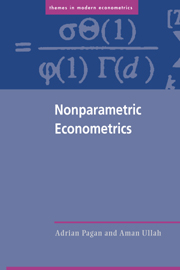Book contents
- Frontmatter
- Contents
- Preface
- 1 Introduction
- 2 Methods of Density Estimation
- 3 Conditional Moment Estimation
- 4 Nonparametric Estimation of Derivatives
- 5 Semiparametric Estimation of Single-Equation Models
- 6 Semiparametric and Nonparametric Estimation of Simultaneous Equation Models
- 7 Semiparametric Estimation of Discrete Choice Models
- 8 Semiparametric Estimation of Selectivity Models
- 9 Semiparametric Estimation of Censored Regression Models
- 10 Retrospect and Prospect
- A Statistical Methods
- References
- Index
6 - Semiparametric and Nonparametric Estimation of Simultaneous Equation Models
Published online by Cambridge University Press: 03 December 2009
- Frontmatter
- Contents
- Preface
- 1 Introduction
- 2 Methods of Density Estimation
- 3 Conditional Moment Estimation
- 4 Nonparametric Estimation of Derivatives
- 5 Semiparametric Estimation of Single-Equation Models
- 6 Semiparametric and Nonparametric Estimation of Simultaneous Equation Models
- 7 Semiparametric Estimation of Discrete Choice Models
- 8 Semiparametric Estimation of Selectivity Models
- 9 Semiparametric Estimation of Censored Regression Models
- 10 Retrospect and Prospect
- A Statistical Methods
- References
- Index
Summary
Introduction
In earlier chapters we have considered single-equation economic models where a dependent variable is a function of other variables. The basic assumption used in these models was that the right-hand side variables X are independent of the error term in the equation and therefore are not affected by the dependent variable Y. We did not allow for the possibility of a reverse causality, or feedback, where Y and X were jointly determined (endogenous) variables. There are a large number of economic models where some of the right-hand side variables are endogenous and these are referred to as a system of simultaneous equations models. Familiar examples are models of markets and the macro economy, as well as sets of factor demand equations. In all of these models, whether we are considering a single equation or a system as a whole, some of the right-hand side variables will be endogenous and hence correlated with the error term. For an overview of such system models, see Judge et al. (1985). In such systems direct application of the semiparametric and nonparametric regression estimators of Chapters 3 to 5 would lead to inconsistent estimators. Consequently, this chapter concentrates upon the modifications needed to those estimators when applied to random variables making up a system.
A primary division in the chapter is between those cases in which only a vector of parameters is unknown within the system and those when the system cannot be given a parametric form. In the first instance one wishes to devise an SP estimator of the parameters.
- Type
- Chapter
- Information
- Nonparametric Econometrics , pp. 254 - 271Publisher: Cambridge University PressPrint publication year: 1999

